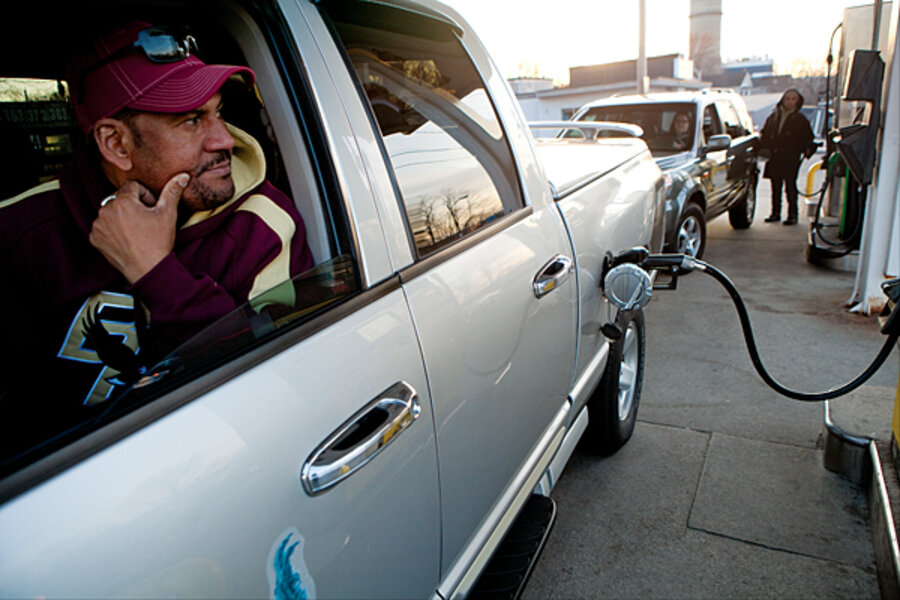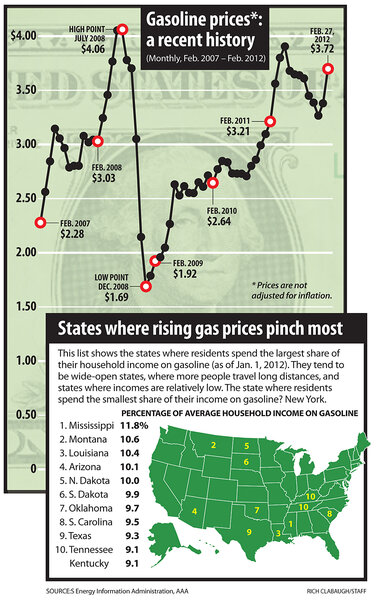Gas prices: How much will they hurt the economy?
The fragile American economy has been painstakingly nursed back toward health with a variety of remedies, ranging from zero percent interest rates and extended tax cuts to the bailout of Detroit and controversial stimulus spending on roads, teacher salaries, and clean energy projects.
Now, soaring fuel prices are threatening to undo it all.
Almost everyone from consumers tanking up the family car to the local pizza deliveryman to giant companies with fleets of cars is feeling it in the wallet as the national price of gasoline heads closer and closer to $4 a gallon.
The price at the pump is rising so quickly that the extra money Americans are spending is absorbing a significant amount of the payroll tax cut that Congress agreed to and President Obama signed into law Feb. 23 to help boost the economy. (For every 10-cent increase in the price of a gallon of gasoline, it costs the economy about $11 billion. By the end of February the price was up 36 cents for the year.)
Economists say if the price stays high for a good part of the year, it could stall the creation of jobs. And higher fuel prices could eventually start to have an unwelcome side effect: spiraling inflation.
"This rise in fuel price is a negative for the economy," says John Silvia, chief economist at Wells Fargo Securities in Charlotte, N.C. "The reality is transportation gets hit and the cost of goods goes up."
The hardest hit? Those drivers who live in the poorest states and those who travel the longest distances. (See map, at right.) However, the price of gasoline has probably risen fastest in California. Since Jan. 1, the price of regular gasoline in the Golden State is up 61 cents a gallon.
For the nation as a whole, some economists now anticipate the price of gasoline at the pump will exceed $4 a gallon by Memorial Day, the official start of the summer driving season.
"If oil prices stay where they are at the end of February [close to $107 a barrel], it means gasoline prices in April and May will be about $4.25 a gallon nationwide," says Mark Zandi, chief economist at Moody's Analytics in West Chester, Pa. "If we stayed there for the year, it would shave about 0.5 [percent] off of gross domestic product growth."
How much would that hurt the economy?
Mr. Zandi says this could result in the loss of 500,000 jobs. "It basically means we don't make any progress on reducing unemployment this year," he says.
However, it could be even worse. Moody's has constructed what Zandi calls "some dark scenarios," including one in which this summer the Iranians shut down the Strait of Hormuz, through which one-fifth of the world's crude oil moves. If that were to happen, Moody's computer models indicate the price of gasoline on a national basis would surpass $5 a gallon.
"That would push us into a recession," he says.
But the future could also be better – a scenario embraced by Zandi and the stock market. Under this economic projection, which holds that a war between Israel and Iran can be avoided, the price of oil begins to recede as fears of conflict abate. As Asian countries, under the pressure of a US-led boycott of Iranian oil, begin to reduce their purchases from Iran, Saudi Arabia will pick up the slack, Zandi assumes. "That will bring the price of oil down below $100 a barrel, and if that happens, we will be OK."
But even if gasoline prices were to level off at current levels, there could still be an adverse impact on the economy. For example, since the beginning of the year, the price of gasoline in North Carolina has increased about 31 cents a gallon. Because the average household drives 88 miles per month, this is an additional monthly outlay of $27.28 since the start of the year.
"That is the equivalent to a meal out for us," says Seth Gross, owner of Bull City Burger and Brewery in Durham, N.C., where a burger costs $6.25.
But Mr. Gross may be hard-pressed to maintain his menu prices if fuel prices don't back off.
"We're getting fuel surcharges from the people who deliver our food, our wine, our grain," he says. "So far, we've had to absorb those increases, but if they don't go back down, we'll have to adjust our prices on the menu."
The hospitality industry is also watching the run-up in gas prices with a wary eye. In past gasoline run-ups, hotels and lodges have had to lure customers with discounts and gas cards. That's already started to happen again. For example, this year in the San Diego area, the Paradise Point Resort & Spa on Mission Bay is offering a $20 credit for gas or a bike rental or a water taxi to SeaWorld, plus a 20 percent discount off the room rate.
Small to medium-size businesses are particularly vulnerable, says Chris Christopher, an economist with IHS Global Insight in Lexington, Mass. "They really don't have the pricing power to negotiate with the big companies, such as FedEx or UPS, and since their customers are feeling the same pinch, they can't pass on the increases," he says.
That's what is happening to Lonnie Pollock, owner of Pollock Paper and Packaging, a distributor of janitorial supplies and paper products in Grand Prairie, Texas. The sharp rise in fuel prices last spring sent the annual fuel bill for his fleet of 100 trucks up by $500,000. This year, he estimates his fuel costs could rise by as much as another $1 million.
But he is wary about passing along those charges. "You don't want to lose a customer over a small charge," he says. Instead, he says his company, which operates in Texas, Georgia, and North Carolina, will try to become "more efficient," perhaps with better route management.
Probably the most affected by the run-up in gasoline prices are the very poor, says Mr. Christopher.
"A lot of Americans live paycheck to paycheck," he says. "And these prices are hurting them hard."







